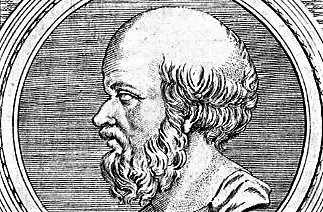Eratosthenes of Cyrene (/ˌɛrətɒsˈθiːniːz/; Ancient Greek: Ἐρατοσθένης ὁ Κυρηναῖος, romanized: Eratosthénēs ho Kyrēnaîos; c. 276 BC – c. 194 BC) was a Greek mathematician, the first geographer, and astronomer. He is credited with being the first person to calculate the circumference of the Earth, which he did by applying a measuring system using stadia, a standard unit of measure during that period. His calculation was remarkably accurate.
Eratosthenes was the chief librarian at the Library of Alexandria. He invented the discipline of geography, including the terminology used today. His calculations about the Earth‘s circumference were far more accurate than any previously made. He also made a calculation of the tilt of the Earth’s axis. Additionally, he may have accurately calculated the distance from the Earth to the sun and invented the leap day. (Most of the credit for the modern leap day is given to Julius Caesar, who introduced it in 45 BC.)
Early life
Eratosthenes was born in 276 BCE in a Greek colony located in present-day Libya. He was educated at the academies of Athens. In 245 BCE, he was invited by Pharaoh Ptolemy III to run the Great Library at Alexandria in Egypt.
He moved to Athens, Greece when he was about 20 years old to study mathematics, astronomy, and philosophy. He returned to Cyrene and became a tutor to the king’s son. After spending some time in Egypt, he returned to Athens and became the librarian at the Library of Alexandria.
The Library of Alexandria
As the librarian, Eratosthenes had access to all the books in the library. He used this opportunity to learn everything he could. He studied mathematics, astronomy, and geography. He also learned about the work of other cultures. He became friends with many of the scholars who came to the library.
Geography
Eratosthenes wrote a treatise about the world called “Geography” while serving as the head librarian and scholar at the Library of Alexandria. This was the first use of the word “geography” which in Greek means “writing about the world.”
Eratosthenes’ work introduced the concepts of different climate zones, including the hot, temperate, and cold zones. His map of the world, though not very accurate, was the first of its kind to feature a grid of parallels and meridians. This grid could be used to estimate distances between different locations.
Although the original “Geography” by Eratosthenes did not survive, today we know what it contained because of reports by Greek and Roman historians.
Friendship with the philosopher Aristarchus of Samos
One of Eratosthenes’ friends was the philosopher Aristarchus of Samos. Aristarchus believed that the Earth rotated on its axis and that the Earth revolved around the sun. This was a controversial idea at the time. Most people believed that the Earth was the center of the universe and that the sun and other planets revolved around the Earth.
Eratosthenes did not immediately accept Aristarchus’ ideas. However, he used his friend’s ideas as a starting point for his own research. He began to study the movement of the sun and stars. He also looked at the shadow of the Earth on the moon during a lunar eclipse. He concluded that Aristarchus was correct and that the Earth did rotate on its axis and revolved around the sun.
Calculation of the circumference of the Earth
Eratosthenes is most famous for his calculation of the circumference of the Earth. He knew that at noon on the summer solstice, the sun was directly overhead at the city of Syene (now Aswan, Egypt). He also knew that at the same time, in Alexandria, the sun was at an angle of 7.2 degrees from vertical. He measured the distance between Alexandria and Syene and found it to be 5000 stadia (about 800 kilometers or 500 miles). He divided this distance by 7.2 degrees and got 700. He then multiplied this number by 360 degrees (the number of degrees in a circle) to get 252,000 stadia (40,233 kilometers or 25,000 miles). This is only about 16 percent off from the actual circumference of the Earth, which is 40,075 kilometers (24,901 miles).
Eratosthenes’ calculation of the Earth’s circumference was not only accurate, but it was also the first time anyone had calculated the circumference of the Earth. He used a simple method that anyone could understand and replicate. His method was so good that it is still used today.
TL;DR
Eratosthenes was not only a great mathematician, but also a great geographer and astronomer. He calculated the distance from the Earth to the sun. He also calculated the tilt of the Earth’s axis. He made a map of the world that was more accurate than any that had been made before. He also invented the discipline of geography.
Eratosthenes was a fantastic thinker. He could think abstractly and see the world in a new way. He was not afraid to question the ideas of others. He was constantly expanding his knowledge. He was indeed a Renaissance man.
